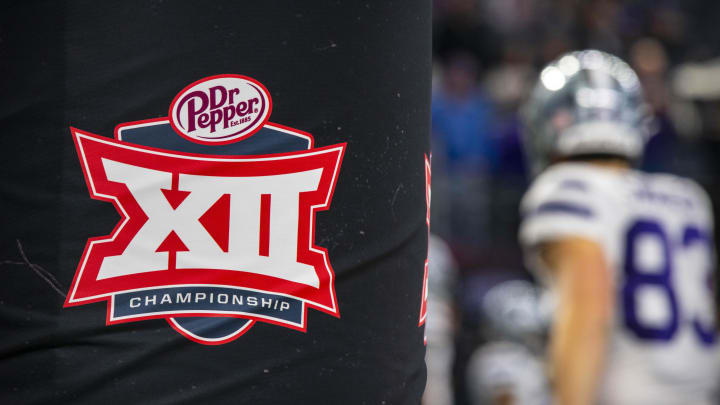Selling Conference Naming Rights May Be a Necessary Concession for the Greater Good

I will not be offended if the Big 12 Conference becomes the Allstate 12 Conference. I will laugh at the league, but I will not be offended. Just don’t name the annoying “Mayhem” guy the next commissioner. Then I would be offended.
I will not be offended if the Atlantic Coast Conference becomes the AT&T ACC. Maybe Lily can talk some dollars and cents into Florida State and Clemson before it’s too late.
I will not be offended if the Southeastern Conference becomes the SEC presented by Dr. Pepper Fansville, and the Big Ten becomes the Wendy’s Baconator Big Ten. Actually, I might be offended by those two—the other leagues are just trying to catch up with you cash hogs, which has led to this potential selling off of identity. Please stand down for five minutes in your pursuit of crushing the competition.
The Jersey Mike’s Mid-American Conference is fine (Danny DeVito can sell MACtion every bit as well as sub sandwiches). I’m O.K. with the Aflac American Athletic Conference. Same with the Liberty Mutual Mountain West (minus the emu, please). The Taco Bell Crunchwrap Supreme Sun Belt. Scattered and Smothered Conference USA presented by Waffle House. Whatever.
Desperate times call for desperate dollar grabs. And if these sorts of everything-is-for-sale gambits help schools avoid cutting or gutting Olympic sports, so be it. Get it done.
Per multiple reports Thursday, selling conference naming rights is the potential new frontier in college sports’ pay the piper/pay the players reckoning. The Big 12 appears to be leading the way, but most other Division I FBS conferences aren’t far behind.
There is a multibillion-dollar bill coming due with the presumptive settlement of multiple lawsuits, a collegiate sea change that will kill amateurism once and for all.
As the powers that be have come to grips with this onrushing new economic reality, all revenue options are on the table. The NCAA already has cleared the way for commercial logos to be placed on fields and courts, with advertising on jerseys also under consideration. This would be a conference-level attempt at a semi-solution.
According to The Action Network, a naming-rights deal could bring in $30 million to $50 million a year for the Big 12. While that’s certainly significant money, it would be divided among 16 member schools—that’s $1.9 million to $3.1 million per school, which is barely enough to buy out a lousy offensive coordinator who was given a bloated three-year contract.
(The Big 12 also is reportedly looking into private equity funding. Private capital is one thing; private equity runs a greater risk of selling off the farm, so to speak. As SEC commissioner Greg Sankey said recently, “There are cautionary tales about private equity out there. I’ve had a half dozen or more meetings with representatives, all good people, all learning opportunities. But I think people have to exercise a level of care before just jumping in.”)
But we are in an environment where every spare million helps. Given the fact that College Sports Inc. long ago sold out tradition for TV revenue, this is no time to stand on a melting iceberg of principle. The entire industry has been swimming in nonsense for decades.
Think about it: If anyone is bothered by the Allstate 12 Conference, why aren’t they bothered by a 16-team league that for years embraced bad math in its name? Same with the Big Ten as it clung to its name while bloating to 11 (Penn State), then 12 (Nebraska), then 14 (Rutgers and Maryland), now 18 (USC, UCLA, Oregon, Washington).
The Atlantic Coast Conference now has two teams on the Pacific coast and one in Texas. Not to mention Louisville (500-plus miles from the coast) and, in all sports but football and ice hockey, Notre Dame (roughly 700 miles). In the current reality, is naming that league after GEICO or Ram Trucks really an affront to anyone’s dignity?
The potential catch here is that it could be an affront to the media companies that pay vast amounts to athletic departments. Would opening up a new revenue stream negatively impact an existing revenue stream?
Because if TV mega-advertiser Allstate decides it wants to sponsor the Big 12 for a decade, that logically would mean it needs to spend less on college athletics advertising on ESPN and Fox. Same with State Farm, Nissan or any other companies that could be contemplating league sponsorship—the money would have to come out of somewhere, and that somewhere could be the pockets of the major TV players.
In my view, the bottom-line need in the new economic reality of college athletics will be finding enough cash to pay the athletes without eliminating Olympic sports. Or, alternatively, reducing some of those sports to zombie entities that operate on a fraction of their current financial commitment. (And a lot of them already are on shoestring budgets.)
Now, there will be some cost containment at the revenue-producing level. Things like football roster sizes are under scrutiny. Football and basketball support staff might be trimmed a little. But rest assured, a great many athletic directors are looking at the sports that don’t make money and gauging how much blowback they would have to take for cutting them.
The caliber of students those sports generally attract, and the positive light they tend to shine on a school, is value in and of itself. They also help a university make money, since a lot of them are not on a full (or any) athletic scholarship and pay hefty tuition bills. If those athletes and sports are deemed expendable, we’ve lost the college athletics plot.
But the upcoming economic realities are daunting, which is why drastic steps have to be considered. If the Big 12’s mathematically incorrect name has to die so the league’s cross country teams can live, that’s a deal that might need to be struck.
